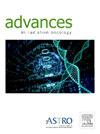A Feasibility Study for Clinical Implementation of hypo fractionated SBRT Program at a Clinic in an LMIC Using Locally Designed Lung Phantom
IF 2.7
Q3 ONCOLOGY
引用次数: 0
Abstract
Purpose
This study aims to assess the feasibility of implementing a hypofractionated radiation therapy (HFRT) program at the Oncology Directorate of Komfo Anokye Teaching Hospital in Ghana, addressing specific infrastructure limitations that hinder patient care and treatment efficiency. Hence, we conducted a feasibility study to start a HFRT lung stereotactic body radiation therapy (SBRT) program using currently available resources. The goal is to alleviate the burden on patients and health care providers, particularly in the context of limited resources.
Methods and Materials
A lung phantom was designed from locally sourced materials consisting of wood slabs to mimic the lung, a perspex tank filled with water for tissue equivalence, and a 3-cm diameter acrylic ball to simulate the tumor. A motion platform was also designed for the phantom to simulate patients breathing in the superior-inferior direction. We acquired 3 computed tomography (CT) scan data sets using a slow CT scan technique for target motions of 0 cm (no_target_motion), 0.5 cm (0.5-cm_target_motion), and 1 cm (1-cm_target_motion) displacements. Treatment plans were generated for each phantom CT image data set using 9-field 6-Mega-Voltage (MV) photon beams in the eclipse treatment planning system. We also generated a treatment plan using an actual patient CT data set to assess the doses to target in the lung and critical organs at risk during a typical lung SBRT treatment. The quality of each treatment plan was evaluated using the near maximum (D2%), near minimum (D98%), mean (Dmean), V100, V95, V90, heterogeneity index (HI), conformity index (CI), the ratio of 50% prescription isodose volume to the PTV volume, (R50%), maximum dose (in % of dose prescribed) at 2 cm from PTV in any direction (D2cm, Gy) and dose-volume-histograms for the planning target volume (PTV). The near maximum (D2%), mean, V5, V10, V15, and V20 values were used as the dose metrics to evaluate the dose to the lung. Maximum dose was used to evaluate the dose to the spinal cord, and the maximum and mean doses were used to evaluate doses to the esophagus, heart, trachea, and ribs.
Results
We quantitatively assessed the quality of the phantom treatment plans by calculating the CI, HI, R50%, and D2cm for each plan. The CI values for the PTV for the no_target_motion, 0.5-cm_target_motion, and 1-cm_target_motion are 1.07, 1.08, and 1.06, respectively. The HIs for the PTV for no_target_motion, 0.5-cm_target_motion, and 1-cm_target_motion are 1.20, 1.10, and 1.20 respectively. The R50% for the no_target_motion, 0.5-cm_target_motion, and 1-cm_target_motion are 3.98, 3.86, and 3.82, respectively, and the corresponding D2cm values are 27.30, 31.64, and 30.47, respectively. The CI, HI, R50%, and D2cm values for the PTV using the actual patient CT data set are 1.08, 1.22, 7.1, and 58.7 respectively. Therefore, our data demonstrate good dose conformity and heterogeneity within the PTV, with a sharp dose fall-off for all cases. The point dose measurements made in the phantom also show good agreement with treatment planning data.
Conclusions
Our results demonstrate that implementing HFRT using 3-dimensional conformal radiation therapy for lung SBRT is feasible with the current infrastructure of our institution. Although the proposed treatment plan is effective, future research on motion management and image guidance technologies is necessary to optimize treatment fidelity. These findings suggest that HFRT could be a viable option for addressing resource constraints in radiation therapy delivery in similar settings.
在LMIC临床应用局部设计肺假体进行低分级SBRT的可行性研究
目的:本研究旨在评估加纳Komfo Anokye教学医院肿瘤学理事会实施低分割放射治疗(HFRT)计划的可行性,解决阻碍患者护理和治疗效率的特定基础设施限制。因此,我们利用现有资源开展了一项启动HFRT肺立体定向放射治疗(SBRT)项目的可行性研究。目标是减轻病人和保健提供者的负担,特别是在资源有限的情况下。方法和材料肺假体由当地材料组成,包括模拟肺的木板,一个充满水的有机玻璃罐,用于组织等效,以及一个直径3厘米的丙烯酸球来模拟肿瘤。同时设计了运动平台,模拟患者上下方向的呼吸。我们使用慢速CT扫描技术获得了3个CT扫描数据集,分别为0 cm (no_target_motion)、0.5 cm (0.5-cm_target_motion)和1 cm (1-cm_target_motion)位移的目标运动。在日食治疗计划系统中使用9场6兆电压(MV)光子束对每个幻影CT图像数据集生成治疗计划。我们还使用实际的患者CT数据集制定了治疗计划,以评估在典型的肺部SBRT治疗期间肺和危险的关键器官的靶向剂量。采用近最大值(D2%)、近最小值(D98%)、平均值(Dmean)、V100、V95、V90、非均质性指数(HI)、一致性指数(CI)、50%处方等剂量体积与PTV体积之比(R50%)、距PTV任意方向2cm处的最大剂量(占处方剂量的百分比)(D2cm, Gy)和计划目标体积(PTV)的剂量-体积-直方图来评价每个治疗计划的质量。以近最大值(D2%)、平均值、V5、V10、V15和V20值作为评价肺剂量的剂量指标。最大剂量用于评估脊髓的剂量,最大和平均剂量用于评估食道、心脏、气管和肋骨的剂量。结果我们通过计算每个方案的CI、HI、R50%和D2cm来定量评估幻影治疗方案的质量。no_target_motion、0.5-cm_target_motion和1-cm_target_motion的PTV的CI值分别为1.07、1.08和1.06。no_target_motion、0.5-cm_target_motion和1-cm_target_motion的PTV HIs分别为1.20、1.10和1.20。no_target_motion、0.5-cm_target_motion和1-cm_target_motion的R50%分别为3.98、3.86和3.82,对应的D2cm值分别为27.30、31.64和30.47。使用实际患者CT数据集,PTV的CI、HI、R50%和D2cm值分别为1.08、1.22、7.1和58.7。因此,我们的数据显示了PTV内良好的剂量一致性和异质性,所有病例的剂量都急剧下降。在幻体中进行的点剂量测量也显示出与治疗计划数据的良好一致性。结论在我院现有的基础设施条件下,采用三维适形放射治疗肺SBRT实施HFRT是可行的。虽然提出的治疗方案是有效的,但未来需要对运动管理和图像引导技术进行研究,以优化治疗的保真度。这些发现表明,HFRT可能是解决类似环境中放射治疗提供资源限制的可行选择。
本文章由计算机程序翻译,如有差异,请以英文原文为准。
求助全文
约1分钟内获得全文
求助全文
来源期刊

Advances in Radiation Oncology
Medicine-Radiology, Nuclear Medicine and Imaging
CiteScore
4.60
自引率
4.30%
发文量
208
审稿时长
98 days
期刊介绍:
The purpose of Advances is to provide information for clinicians who use radiation therapy by publishing: Clinical trial reports and reanalyses. Basic science original reports. Manuscripts examining health services research, comparative and cost effectiveness research, and systematic reviews. Case reports documenting unusual problems and solutions. High quality multi and single institutional series, as well as other novel retrospective hypothesis generating series. Timely critical reviews on important topics in radiation oncology, such as side effects. Articles reporting the natural history of disease and patterns of failure, particularly as they relate to treatment volume delineation. Articles on safety and quality in radiation therapy. Essays on clinical experience. Articles on practice transformation in radiation oncology, in particular: Aspects of health policy that may impact the future practice of radiation oncology. How information technology, such as data analytics and systems innovations, will change radiation oncology practice. Articles on imaging as they relate to radiation therapy treatment.
 求助内容:
求助内容: 应助结果提醒方式:
应助结果提醒方式:


